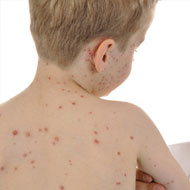- Toddler Measles Symptoms
- Toddler Flu Treatment
- Toddler Flu Symptoms
- Toddler Stomach Flu Symptoms
- Toddler Hair Loss
- Toddler Urinary Tract Infection Symptoms
- Toddler Tonsillectomy Recovery
- Toddler Periorbital Cellulitis
- Toddler Vomiting and Diarrhea
- Types of Toddler Vomiting
- Toddler Vomiting Treatment
- Toddler Cough Vomit
- Toddler Dandruff
- Toddler Bowlegs
- Toddler Eye Infection
- Toddler Pink Eye
- Toddler Pink Eye Symptoms
- Toddler Eye Problems
- Toddler Hearing Loss Signs
- Symptoms Of Pinworms In Toddlers
- Toddler Blood Infection
- Toddler Mononucleosis
- Toddler Motion Sickness
- Toddler Labial Adhesion
- Lyumphoma in Toddlers
- Toddler Scabies
- Toddler Pinworms
- Toddler Insect Bites
- Toddler Meningitis
- Toddler Moles
- Toddler Lyme Disease
- Toddler Nosebleeds
- Toddler Ingrown Toenail
- Toddler Lead Poisoning
- Toddler Hair Loss Alopecia Areata
- Toddler Heat Stroke
- Toddler Rubella
- Toddler Tonsillectomy
- Toddler Iron-Deficiency Anemia
- Toddler Tooth Discoloration
- Toddler Concussion
- Toddler Psoriasis
- Toddler Sunburn
- Toddler Tongue Blisters
- Toddler Impetigo
- Toddler Blepharitis
- Toddler Burns
- Toddler Burn Treatment
- Toddler Eczema Face
- Toddler Eczema Symptoms
- Toddler Urinary Tract Infection
- Toddler Boy Urinary Tract Infection
- Toddler Epilepsy
- Toddler Epilepsy Symptoms
- Toddler Walking Pneumonia
- Toddler Yeast Infection Symptoms
- Toddler Frostbite
- Toddler Hand Foot And Mouth Disease
- Toddler Dry Scalp
- Toddler Dry Skin
- Toddler Strep Throat
- Toddler Strep Throat Symptoms
- Toddler Sore Throat
- Toddler Mumps
- Toddler Bacterial Infection
- Shaken Baby Syndrome
- Shaken Baby Syndrome Symptoms
- Toddler Tonsillitis
- Toddler Eye Discharge
- Toddler Fifth Disease
- Toddler Febrile Seizures
- Toddler Food Poisoning
- Toddler Gingivostomatitis
- Toddler Stomach Ache
- Toddler Warts
- Toddler Tuberculosis
- Toddler Torticollis
- Toddler Tick Bites
- Toddler Ear Infection Remedies
- Toddler Ear Infection Symptoms
- Toddler Ear Infection Signs
- Toddler Concussion Signs
- Toddler Bronchitis
- Toddler Colds
- Toddler Chicken Pox
- Toddler Appendicitis
- Toddler Asthma
- Toddler Birthmarks
- Toddler Strabismus
- Toddler Wheezing
- Toddler Sprains
- Toddler Viral Infection
- Toddler Yeast Infection
- Toddler Hives
- Toddler Canker Sores
Symptoms & Treatment For Pityriasis Versicolor In Toddlers
Tinea versicolor, a rather common fungal infection, also called pityriasis versicolor, is known to affect toddlers pretty often. The result is those many flat spots you see on your little one. These are caused by a combination of susceptibility to the fungal infection and the conditions being right.
Now these small spots can vary in appearance and in how they feel. For instance, they could itch a little or could be flaky.
Signs of Toddlers Tinea Versicolor
Extremely fine scales may be visible on these patches. Even the color could range from lighter to possibly darker than the tone of the surrounding area of skin. The former is known as hypopigmentation while the latter is referred to as hyperpigmentation. You could find a number of spots actually seem to blend into what appears to be bigger patchy areas.
These usually crop up on oily areas of your toddler's body. This is because this fungus thrives on oily skin. Examples include his or her chest and underarms. The good news is that this particular fungal skin infection is neither contagious nor does tinea versicolor pose any health issues for the child. The problem is typically the result of an excessive growth of a fungus which usually lives on one's skin. This Pityrosporum ovale is found in your pores and, like most fungus, flourished under conditions that are both clammy and warm.
Thus, your toddler is more likely to experience these patches when summer comes round. More than toddlers, this skin condition is more likely to affect adolescents.
Treatment for Toddlers Tinea Versicolor
Your doctor should be able to advise the best course of Tinea versicolor treatment for your toddler's Tinea versicolor. If he or she does not appear to be much affected by these flat spots, your doctor may recommend something as simple as a particular kind of over-the-counter dandruff shampoo. The ingredient needed in such shampoos is selenium sulfide. What you would then need to do is spread this all over, going beyond the flat spot borders. Try to keep the layer thin and then rinse after approximately a quarter of an hour. While the fungus might go away in a few weeks after using this treatment every night, understand that the skin's appearance might take months to revert to its normal state. Keeping the toddler dry as well as cool can help in this case. Your child's doctor might also prescribe some kind of topical antifungal medicine so do check with him or her before treating the child at home.


